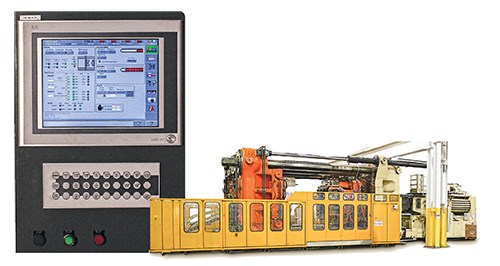Big Presses Get New Lease on Life With Control Retrofits
Updated controls save some very large machines from obsolescence.
One of the largest injection machines in North America gained new life last year from a “brain transplant”—a controls upgrade that converted it from a constant headache to trouble-free operation. The press was a one-of-a-kind machine (photo) built in 1999 with an 8800-ton clamp having eight tiebars, three of which retract for mold changes; a plunger/shot-pot injection unit fed by a reciprocating extruder; and a seven-axis, side-entry robot. The machine had been acquired along with a defunct molding plant in Shelbyville, Ky., by Macro Plastics of Fairfield, Calif., a producer of reusable bulk containers. Unfortunately, the giant machine, originally built for Chrysler, had problems with its control system. “We could never depend on the press to run for more than a few hours without a cycle stoppage,” says plant manager Jonathan Kitchen. “We have another machine capable of handling the largest jobs. Moving the 77,000-lb mold back and forth between machines each time we had a problem was an arduous job, requiring two days of downtime.”
Macro called in Cincinnati Process Technologies (CPT), Cincinnati, a provider of injection machinery upgrades and other services. Sales manager Dane Bales says CPT has concentrated lately on upgrading large machines because “it’s easier to see the benefit of preserving that big capital investment with a retrofit.” The Macro case “was the largest and most complex control system replacement we’ve done to date,” says CPT application engineer Jim O’Bryan. CPT installed control hardware from Atlanta-based B&R Industrial Automation (which it uses exclusively), along with CPT’s own software. Says Macro’s Kitchen, “Now we can start it up and it will run continuously without so much as a glitch.”
CPT accomplished other big projects in 2014. It outfitted new controls on one of the largest low-pressure structural-foam machines in the world for Infiltrator Systems to produce large septic ad potable-water tanks in Winchester, Ky. Each PP tank measures up to 15 ft long and weighs 245 lb. They are molded on a mammoth press that Infiltrator constructed by joining together the clamps from two 1990s-era foam presses, for a total of 6000 tons of clamp force. The two injection units, plus a third, were mounted on this custom machine. For the control, CPT used B&R’s Panel PC with 15-in. touchscreen (photo). Due to the machine size, four I/O racks were located closest to their points of use, which drastically reduced the amount of wire and assembly time.
Last year, CPT also retrofitted two 750-ton structural-foam presses from the 1990s at Buckhorn Industries in Bluffton, Ind., and will do a third at the firm’s Springfield, Mo., facility. Buckhorn molds large reusable bulk containers weighing up to 150 lb. Buckhorn aimed to install sequential valve gating (SVG) on these machines to cut material loss by reducing overfilling and improve part quality through tighter knit-line control and consistent cavity filling in molds with high length-to-thickness ratios. With SVG and new controls from CPT, Buckhorn saw better fills, shorter cycles, and more than 20% reduction in clamp tonnage. Rex Reynolds, Buckhorn maintenance manager at Bluffton, says the upgrade will extend machine life and provide energy and material savings well beyond the estimated two-year ROI for the project.
CPT, which will exhibit at NPE2015 this month in Orlando, Fla., also supplies Asian Plastic Machinery and Borche injection presses, Wetec robots and automation systems, new and remanufactured parts, screws and barrels, variable-speed drives, and energy-efficient lighting.
Related Content
Know Your Options in Injection Machine Nozzles
Improvements in nozzle design in recent years overcome some of the limitations of previous filter, mixing, and shut-off nozzles.
Read MoreHow to Optimize Pack & Hold Times for Hot-Runner & Valve-Gated Molds
Applying a scientific method to what is typically a trial-and-error process. Part 2 of 2.
Read MoreBest Methods of Molding Undercuts
Producing plastics parts with undercuts presents distinct challenges for molders.
Read MoreImprove The Cooling Performance Of Your Molds
Need to figure out your mold-cooling energy requirements for the various polymers you run? What about sizing cooling circuits so they provide adequate cooling capacity? Learn the tricks of the trade here.
Read MoreRead Next
People 4.0 – How to Get Buy-In from Your Staff for Industry 4.0 Systems
Implementing a production monitoring system as the foundation of a ‘smart factory’ is about integrating people with new technology as much as it is about integrating machines and computers. Here are tips from a company that has gone through the process.
Read MoreHow Polymer Melts in Single-Screw Extruders
Understanding how polymer melts in a single-screw extruder could help you optimize your screw design to eliminate defect-causing solid polymer fragments.
Read MoreAdvanced Recycling: Beyond Pyrolysis
Consumer-product brand owners increasingly see advanced chemical recycling as a necessary complement to mechanical recycling if they are to meet ambitious goals for a circular economy in the next decade. Dozens of technology providers are developing new technologies to overcome the limitations of existing pyrolysis methods and to commercialize various alternative approaches to chemical recycling of plastics.
Read More



























